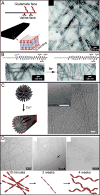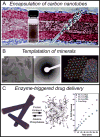Supramolecular Nanofibers of Peptide Amphiphiles for Medicine
- PMID: 24532851
- PMCID: PMC3922220
- DOI: 10.1002/ijch.201300046
Supramolecular Nanofibers of Peptide Amphiphiles for Medicine
Abstract
Peptide nanostructures are an exciting class of supramolecular systems that can be designed for novel therapies with great potential in advanced medicine. This paper reviews progress on nanostructures based on peptide amphiphiles capable of forming one-dimensional assemblies that emulate in structure the nanofibers present in extracellular matrices. These systems are highly tunable using supramolecular chemistry, and can be designed to signal cells directly with bioactive peptides. Peptide amphiphile nanofibers can also be used to multiplex functions through co-assembly and designed to deliver proteins, nucleic acids, drugs, or cells. We illustrate here the functionality of these systems describing their use in regenerative medicine of bone, cartilage, the nervous system, the cardiovascular system, and other tissues. In addition, we highlight recent work on the use of peptide amphiphile assemblies to create hierarchical biomimetic structures with order beyond the nanoscale, and also discuss the future prospects of these supramolecular systems.
Figures









Similar articles
-
Emerging peptide nanomedicine to regenerate tissues and organs.J Intern Med. 2010 Jan;267(1):71-88. doi: 10.1111/j.1365-2796.2009.02184.x. J Intern Med. 2010. PMID: 20059645 Free PMC article. Review.
-
Supramolecular Assembly of Peptide Amphiphiles.Acc Chem Res. 2017 Oct 17;50(10):2440-2448. doi: 10.1021/acs.accounts.7b00297. Epub 2017 Sep 6. Acc Chem Res. 2017. PMID: 28876055 Free PMC article.
-
Hydrogen Bonding Stiffens Peptide Amphiphile Supramolecular Filaments by Aza-Glycine Residues.Acta Biomater. 2021 Nov;135:87-99. doi: 10.1016/j.actbio.2021.08.044. Epub 2021 Sep 2. Acta Biomater. 2021. PMID: 34481055
-
Transforming Growth Factor β-1 Binding by Peptide Amphiphile Hydrogels.ACS Biomater Sci Eng. 2020 Aug 10;6(8):4551-4560. doi: 10.1021/acsbiomaterials.0c00679. Epub 2020 Jul 8. ACS Biomater Sci Eng. 2020. PMID: 33455189
-
Designed peptide amphiphiles as scaffolds for tissue engineering.Adv Colloid Interface Sci. 2023 Apr;314:102866. doi: 10.1016/j.cis.2023.102866. Epub 2023 Feb 27. Adv Colloid Interface Sci. 2023. PMID: 36898186 Review.
Cited by
-
Peptide hormones and lipopeptides: from self-assembly to therapeutic applications.J Pept Sci. 2017 Feb;23(2):82-94. doi: 10.1002/psc.2954. Epub 2017 Jan 27. J Pept Sci. 2017. PMID: 28127868 Free PMC article. Review.
-
Tuning Structural Organization via Molecular Design and Hierarchical Assembly to Develop Supramolecular Thermoresponsive Hydrogels.Macromolecules. 2024 Jul 3;57(14):6606-6615. doi: 10.1021/acs.macromol.4c00567. eCollection 2024 Jul 23. Macromolecules. 2024. PMID: 39071041 Free PMC article.
-
Self-assembly of biomolecular soft matter.Faraday Discuss. 2013;166:9-30. doi: 10.1039/c3fd00120b. Faraday Discuss. 2013. PMID: 24611266 Free PMC article.
-
Biomaterials via peptide assembly: Design, characterization, and application in tissue engineering.Acta Biomater. 2022 Mar 1;140:43-75. doi: 10.1016/j.actbio.2021.10.030. Epub 2021 Oct 25. Acta Biomater. 2022. PMID: 34710626 Free PMC article. Review.
-
Evaluation of cylindrical micelles assembled from amphiphilic β-peptides as antigen delivery nanostructures.Nanoscale Adv. 2025 Mar 20;7(10):2979-2987. doi: 10.1039/d5na00166h. eCollection 2025 May 13. Nanoscale Adv. 2025. PMID: 40177387 Free PMC article.
References
Grants and funding
LinkOut - more resources
Full Text Sources
Other Literature Sources
